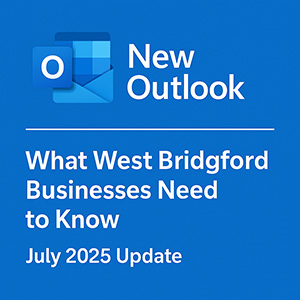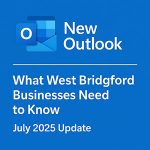 If you're a small business owner in West Bridgford, chances are your email and calendar are the beating heart of your day-to-day operations. Whether you're chasing leads, booking appointments, or keeping your team in sync, Microsoft Outlook probably plays a key role in how your business runs. But a big change is on the horizon, and it's already started rolling out.
If you're a small business owner in West Bridgford, chances are your email and calendar are the beating heart of your day-to-day operations. Whether you're chasing leads, booking appointments, or keeping your team in sync, Microsoft Outlook probably plays a key role in how your business runs. But a big change is on the horizon, and it's already started rolling out.
Microsoft is in the middle of a major update to Outlook for Windows. They're replacing the classic version with a completely new app, and for many Microsoft 365 users, the switch is being made automatically. That means you could wake up one morning, open your laptop, and find that your entire email interface has changed, ready or not.
This blog will walk you through what’s happening, what it means for small businesses in and around West Bridgford, and what steps you can take to stay in control. Whether you're ready to embrace the new features or need time to prepare, this is your guide to navigating the Outlook 2025 transition with clarity and confidence.
📅 Updated Timeline for Outlook 2025 Migration (As of 31 July 2025)
| Phase | Scope | Timeline & Details |
| Manual Opt-In | Available globally | Available since August 2024. Users can switch manually. |
| Auto-Install | Windows 10/11 desktops | Began February 2025 via Windows Update. |
| SMB Forced Migration | Microsoft 365 Business Standard/Premium | Auto-switch began January 6, 2025. Users may revert, but classic is being phased out. |
| Enterprise Phase | Enterprise Licenses (E plans) | Scheduled to begin April 2026. Admin and user notifications required. |
| Full Cutover | All subscription-based Outlook users | Expected 2027–2029. Classic Outlook deprecated; full support ends by 2029. |
Quick Summary: If you're using Microsoft 365 Business Standard or Premium in West Bridgford, the automatic switch to the new Outlook likely already began. By 2029, the classic version will no longer be supported.
What's New and What's Still Missing in New Outlook?
The new Outlook promises a sleeker interface, better cross-platform syncing, and smart features powered by Microsoft’s Copilot AI. But it’s not all smooth sailing, particularly for businesses with established workflows.
Here’s what you need to know:
- Legacy Add-Ins: COM and VBA-based tools are not supported. Only web add-ins work.
- Offline Access: Local email caching is limited to 180 days (versus indefinite in classic Outlook).
- PST Files: Read-only mode supported since Nov 2024.
- Encryption: S/MIME encryption was added in Jan 2025.
- Interface & AI: Modern design with Microsoft Copilot integration, but advanced workflows may still be restricted.
These limitations could impact productivity and security if your business relies on automation, heavy offline access, or legacy systems.
Cybersecurity Risks and Data Privacy Concerns
Outlook isn't just about emails — it's about the sensitive information that lives inside them. That’s why this update raises important cybersecurity and compliance questions for small businesses.
- Cloud-First Email Routing
Non-Microsoft email accounts (e.g., Gmail or IMAP) now route through Microsoft servers, potentially raising GDPR and data privacy concerns. - Less Control for Admins
The new Outlook restricts storage location and retention policies. This can weaken your data governance compared to Classic Outlook. - Add-In Gaps Could Affect Security Tools
If your business uses COM add-ins for encryption or compliance, those tools won’t work in the new version. Check with your IT team now. - Greater Exposure During Transition
Software migrations increase vulnerability windows. In June 2025 alone, Microsoft issued patches for several remote code execution risks. - AI Tools Add Risk
Outlook's Copilot and Loop integration can accidentally surface confidential data to unintended users if not properly configured.
For any business handling sensitive client information, this is more than a tech upgrade — it’s a potential compliance risk. Planning ahead is vital.
How to Block the New Outlook (If You’re Not Ready)
You can still block the forced switch and stay on Classic Outlook (for now) using the Windows Registry:
HKEY_CURRENT_USER\Software\Policies\Microsoft\office\16.0\outlook\preferences
"NewOutlookMigrationUserSetting" dword:00000000
WARNING: Editing the registry is risky. Back up first or speak to your IT support provider. Local IT firms in West Bridgford can implement this for you safely.
West Bridgford & Nottingham Business Action Plan
To protect your business operations, ensure compliance, and avoid disruption:
- Check your Microsoft 365 licence type (Standard, Premium, or Enterprise).
- Audit your email tools identify any critical add-ins or offline workflows.
- Review your GDPR/data privacy policy to align with cloud storage models.
- Evaluate Copilot use if enabled, ensure data access policies are defined.
- Block the migration if you’re not ready (before the switch is irreversible).
- Schedule internal training if switching, prepare your staff now.
- Apply Microsoft’s July 2025 patches to close known Outlook vulnerabilities.
Final Thoughts
You didn’t choose this Outlook migration. But you can choose how you respond.
For small businesses around West Bridgford, this is your chance to either take control or be caught off guard. Classic Outlook will be retired by 2029, but you don’t have to jump now. You just need a strategy.
Your tech should empower your business, not trip it up. If you're still unsure whether to migrate, hold off, or optimise, speak to a trusted local IT partner today.
Use the button below to book a 10 minute Discovery Call, and we will discuss how we can better protect your business from the bad guys, to help you sleep better at night, knowing that you have one less thing to worry about.
Also, don’t forget to sign up to our free weekly Cyber Security Tips, delivered to your inbox every Tuesday, link also in description below.



